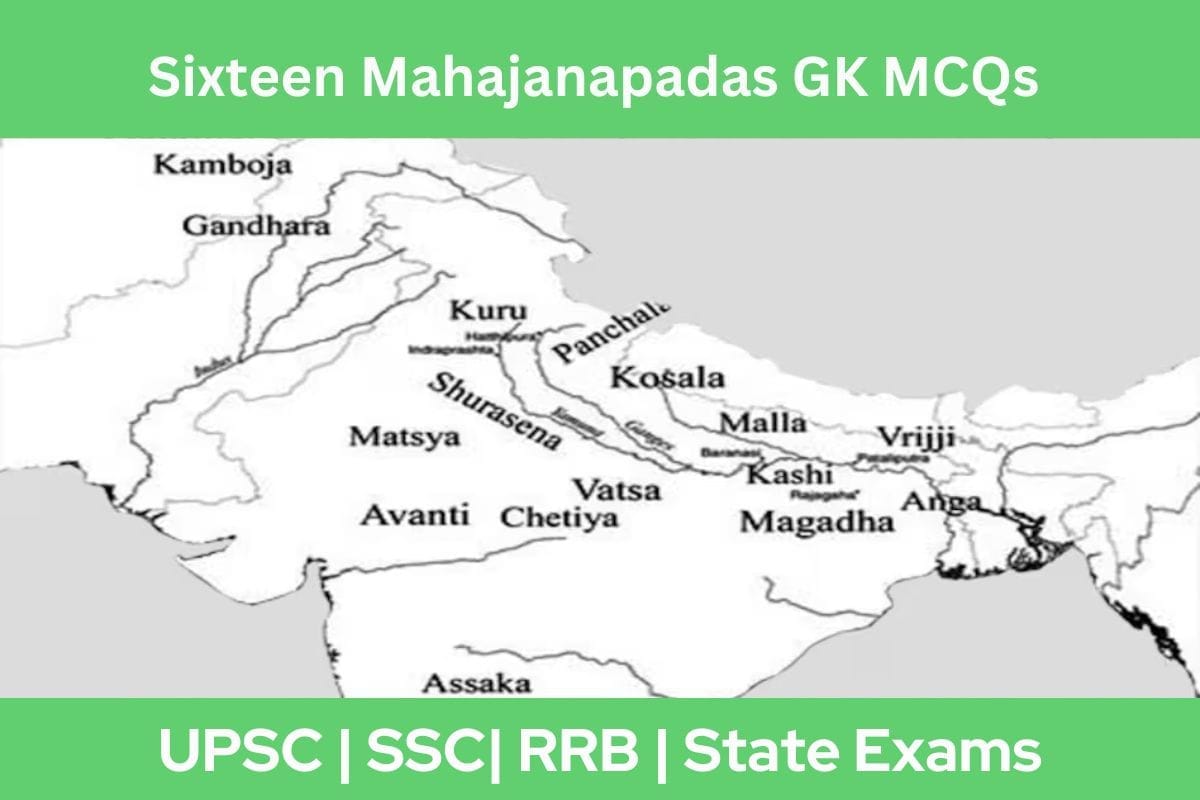
The ancient Indian subcontinent witnessed the emergence of powerful and influential states known as the Sixteen Mahajanapadas. This set of ten multiple-choice questions (MCQs) with detailed answers and explanations is tailored for government job comparative exams. Delve into the rich historical tapestry of the Mahajanapadas and enhance your knowledge for competitive success.
MCQs with Answers and Explanations:
1. Which among the following was the capital of Vatsa Mahajanapada?
- Mathura
- Bairath
- Kausambi
- Kashi
Show Answer
Correct Answer: Kausambi
Kausambi served as the capital of the Vatsa Mahajanapada, an ancient political entity in India. This Mahajanapada was located along the banks of the Yamuna River. It was a significant city during its time and played a role in the political landscape of ancient India. Vatsa Mahajanapada was known for its fine cotton textiles.”
2. Which of the following kings opposed Alexander?
- Ambhi
- Porus
- Dhananada
- Chandragupta
Show Answer
Correct Answer: Porus
Porus, also known as King Porus, is renowned for his resistance against the invasion of Alexander the Great in the Indian subcontinent. In 326 BCE, King Porus led his army against Alexander at the Battle of the Hydaspes River (modern Jhelum River) in the Punjab region. Although Porus was defeated, his bravery and determination in facing one of history’s most formidable conquerors earned him respect.
3. Which of the following is known as an era of ‘Second Urbanisation’?
- Third century BCE
- Second century BCE
- Sixth century BCE
- Seventh century BCE
Show Answer
Correct Answer: Sixth century BCE
The term “Second Urbanisation” refers to a historical period in the 6th century BCE when urban centers and towns emerged in the Indian subcontinent. This development came after a gap of more than a thousand years following the decline of the urban centers of the Indus Valley Civilization. The Second Urbanisation marked a significant transformation in the socio-economic and political landscape of the region.
4. What were the rich peasants called in the 6th century BCE?
- Gramabhojaka
- Gahapati
- Gramakas
- Kammikas
Show Answer
Correct Answer: Gahapati
The rich peasants during the 6th century BCE were known as Gahapatis. These individuals were affluent landowners and held substantial influence in agrarian society. Their economic status allowed them to play a significant role in the agricultural sector, and they were an integral part of the economic structure of their time.
5. Where was the earliest capital of Magadha Kingdom?
- Pataliputra
- Rajgir
- Vaishali
- Avanti
Show Answer
Correct Answer: Pataliputra’
Pataliputra, also known as Pataliputta, was the earliest capital of the Magadha Kingdom. Located in the Ganges River basin, this ancient city became a major political and cultural center. It later served as the capital of several powerful empires, including the Maurya and Gupta dynasties.
6. What was the amount of produce to be paid by the peasants as tax during the 6th century BCE?
- 1/4th of total produce
- 1/5th of total produce
- 1/10th of total produce
- 1/6th of total produce
Show Answer
Correct Answer: 1/6th of total produce
During the 6th century BCE, peasants were required to pay one-sixth of their total produce as taxes. These taxes were collected by royal agents and played a crucial role in the revenue system of the time. These taxes contributed to the income of the state and were collected from the agricultural sector.
7. Which century marked the emergence of the notion of private property?
- 7th century BCE
- 6th century BCE
- 8th century BCE
- 1st century AD
Show Answer
Correct Answer: 6th century BCE
The emergence of the notion of private property in the 6th century BCE marked a significant shift in land ownership. Land holdings began to be granted to individuals, and references to the gifting and sale of land became evident. This change in landownership and property rights reflected evolving socio-economic dynamics.
8. With reference to the 6th century BCE, which site gives an account of the transition from rural to urban life?
- Atranjikhera
- Taxila
- Avantipura
- Kosala
Show Answer
Correct Answer: Atranjikhera
The excavated site of Atranjikhera, situated in present-day Etah, Uttar Pradesh, provides valuable archaeological evidence about the transition from rural to urban life in the 6th century BCE. It offers insights into changing socio-economic structures, urbanization, and the material culture of the time.
9. What were the higher officials in the king’s court called in the 6th century BCE?
- Mantrin
- Amatyas
- Mantrin
- Senanayaka
Show Answer
Correct Answer: Amatyas
During the 6th century BCE, the higher officials in the king’s court were referred to as Amatyas or Mahamatras. These officials held important administrative positions and played a key role in assisting the king in governance and administration.
10. What was the advisory council of the king called in the 6th century BCE?
- Sabha
- Parishad
- Samiti
- Ayuktas
Show Answer
Correct Answer: Parishad
The advisory council of the king during the 6th century BCE was known as the Parishad. This council consisted primarily of Brahmanas and provided counsel and guidance to the king in matters of governance. It was an important component of the political structure in many ancient Indian states.
Sixteen Mahajanapadas Notes for UPSC Exam




Leave a Reply